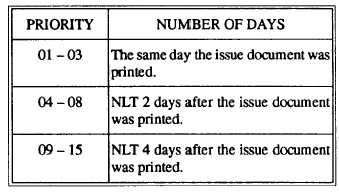required by the item manager, type commander, or
other authorities. An example of a nonscheduled
i n v e n t o r y is
the
spot
inventory.
A
bulkhead-to-bulkhead inventory of specified
storeroom(s) or a specific commodity that is required
as a result of an unsatisfactory random sampling or
supply management inspection is an example of
nonscheduled inventories.
ASHORE
The NAVSUPINST 4440.115 describes the
physical inventory program for shore activities. The
AKs assigned to shore billets are responsible for
managing only a small portion of supply stock. The
AKs are responsible for the supply assets located in the
aviation support division (ASD)/supply support center
(SSC). Personnel assigned to shore billets should
familiarize themselves with the inventory program to
cope with reorganizations.
Physical Inventory Requirements
The physical inventory required ashore is classified
as the unscheduled and scheduled inventory as
described in the following paragraphs.
UNSCHEDULED INVENTORY.— This in-
ventory is conducted as a result of the following:
1. Spot Inventories of Warehouse Refusals. These
are usually caused by errors between the stock records
and the actual location. A warehouse refusal occurs
when stock point records indicate an on-hand balance
but the material cannot be located to satisfy a
requisition. Processing the warehouse refusal results in
customer credit, referral of the requisition, adjustment
of stock record balance to zero, and the processing of
an inventory adjustment. The procedures for
processing warehouse refusals are listed in enclosure 2
of NAVSUPINST 4440.115. The stock points that do
not elect to use this procedure must conduct a spot
inventory of all warehouse refusals with a total dollar
value greater than 0 (excluding DLA-owned
material).
NOTE: A spot inventory must be conducted for all
sensitive or pilferable items that have experienced a
warehouse refusal.
To ensure timely processing of requisitions, the
potential warehouse refusal must be researched and
resolved according to the time frames in Table 5-2.
Table 5-2.-Warehouse Refusal Time Frame
2. In-house Receipt Losses. An inventory must be
conducted for all in-house receipt losses with a dollar
value over 0.
3. Location Survey.
An inventory must be
conducted if the following stock record differences are
identified:
l
l
l
The material was found in an unrecorded
location
Potential gains (material is in the location, but
stock record shows zero balance)
Potential losses (material not in location, but
stock record shows there is material on-hand)
4. Selected Item Inventory. This is requested
locally when a known or suspected imbalance exists
between the recorded and actual on-hand balance, or to
resolve a Report of Discrepancy (ROD).
5. Naval Inventory Control Point/Defense Supply
Center (NAVICP/DSC) Directed Inventory. The
physical inventory requests are generated by the
NAVICP/DSC when a bounceback is received and the
research
exists:
l
l
reveals that one of the following conditions
The bounceback is for condition code A
material and the on-hand system asset in A
condition is less than the projected quarterly
demand.
The bounceback is for a fleet-controlled item
(any condition).
NOTE: The NAVICP/DSC freezes their records to
prevent processing of requisitions until the results of
inventory is received.
The NAVICP/DSC may also request for location
reconciliation to resolve record/quantity mismatches.
A physical inventory of assets is also required before
5-7

